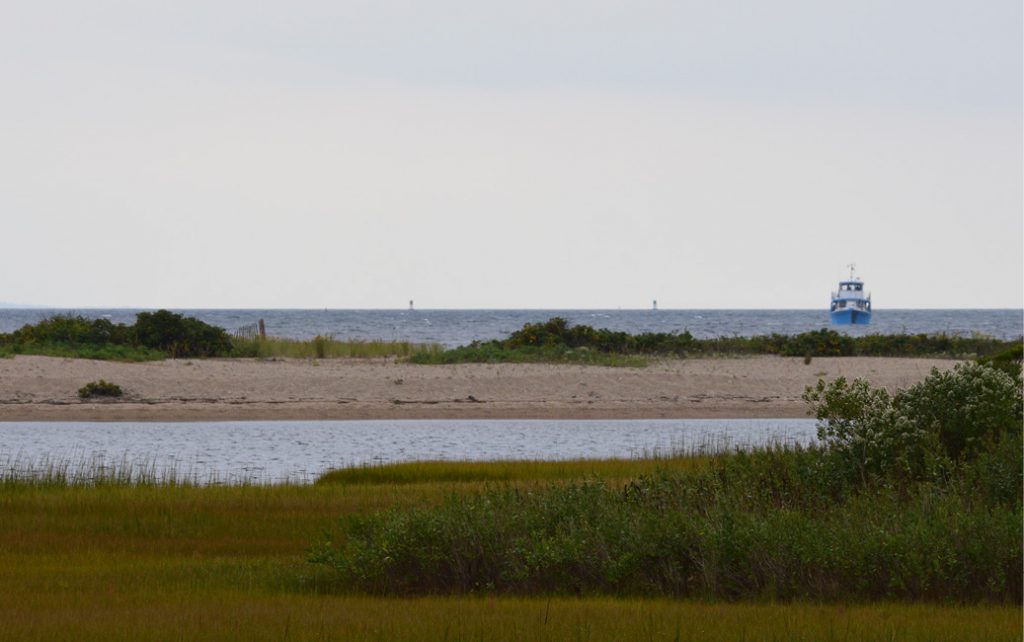By Jamie Vaudrey, UConn; Kevin O’Brien, CT DEEP; and Anthony Allen, Save the Sound
On January 14, 2022, the National Oceanic & Atmospheric Administration (NOAA) announced that a network of state-owned properties in southeastern Connecticut and portions of the surrounding waters was designated as the nation’s 30th National Estuarine Research Reserve (NERR).
The NERR System is a network of coastal sites across the country designated to protect and study estuarine systems. Established through the Coastal Zone Management Act, they represent a partnership between NOAA and coastal states. NOAA provides funding and national guidance, and each reserve is led by a state organization with input from local partners. A NERR provides a variety of resources such as municipal trainings on coastal best management practices, K-12 programs to engage students and teachers in hands-on science, estuarine research studies and long-term monitoring, and programs for environmental stewardship.

Bluff Point marsh and dunes in Groton, CT Photo by Kevin P. O’Brien
The Connecticut Department of Energy and Environmental Protection (DEEP) worked collaboratively with NOAA, the University of Connecticut (UConn), Connecticut Sea Grant (CTSG), the Connecticut Audubon Society (CAS), and numerous other organizations and individuals to lead the designation process. The resulting Connecticut NERR (CT NERR) includes the land areas of Lord Cove Natural Area Preserve (NAP), Roger Tory Peterson NAP, Pine Island, Haley Farm State Park, and Bluff Point State Park/Coastal Reserve/NAP, as well as portions of Long Island Sound and the lower Thames and Connecticut Rivers. It also includes the DEEP Marine District Headquarters in Old Lyme to provide facility support space, and the UConn Avery Point campus in Groton, which will serve as the CT NERR headquarters. UConn will serve as the lead state agency responsible for the CT NERR programs and goals. As the property owner and land manager of many the components, DEEP is recognized as a formal partner via a Memorandum of Agreement.
The designation process began in 2016 to identify and assess possible locations. From those, a nominee was submitted to NOAA in 2019. After review and acceptance by NOAA, an Environmental Impact Statement (EIS) was completed 2021, along with a Management Plan to outline how the CT NERR will operate. At all stages, input from stakeholders—including Save the Sound and other environmental groups—helped ensure a successful outcome, and the effort received support from state, local and private organizations, as well as community leaders who recognized the benefits a NERR can provide.
All reserves administer four core programs using similar protocols to ensure they are both locally relevant and nationally significant. These programs – Research and Monitoring, Education, Coastal Training, and Stewardship – are tailored to focus on both national as well as local issues and priorities. In Connecticut these include Climate Change and Rising Sea Levels, Endangered Species and Habitat Conservation, Pollution Control and Water Quality Improvements, and Training for Coastal Decision-Makers. To address these, the CT NERR Management Plan provides a long-term vision and mission, as well three primary goals to guide the next five years.
The vision of the CT NERR is a resilient, healthy Long Island Sound estuary and watershed where human and natural communities thrive, with a mission to collaboratively integrate science with conservation, learning, recreation, and economic viability using ecologically diverse sites in southeastern Connecticut. Programs and efforts will seek to realize these through the following goals:
• Goal 1: Increase our understanding of the effects of human activities and natural events through collaborative research and monitoring to improve informed decision-making and support adaptive management of coastal ecosystems.
• Goal 2: Strengthen stewardship, protection, and management of estuaries and their watersheds through place-based approaches to training and education to maintain and enhance natural environments.
• Goal 3: Advance environmental appreciation and scientific literacy utilizing a place-based approach, to enhance people’s ability to make science-based decisions that positively affect estuaries, watersheds, and coastal communities.
These goals grew out of the same collaboration that it will take to implement them, a promising start to what has the potential to be a transformative effort. According to the latest models, sea levels along the Connecticut coast are expected to rise by up to 20 inches by 2050—equivalent to the cumulative sea level rise experienced nationally over the past century. With the launch of the CT NERR comes increased capacity for long-term monitoring in coastal and estuarine ecosystems, and an opportunity to assess the resilience of various coastal ecosystems as climate change projections are updated. This sort of research and monitoring is necessary and woefully underfunded, and is key to fully understanding and facing the challenges facing Connecticut and the Long Island Sound. ■
1. CIRCA – SLR About | Connecticut Institute for Resilience & Climate Adaptation (CIRCA) (uconn.edu)
